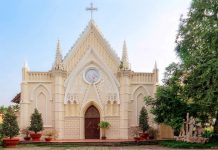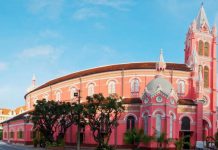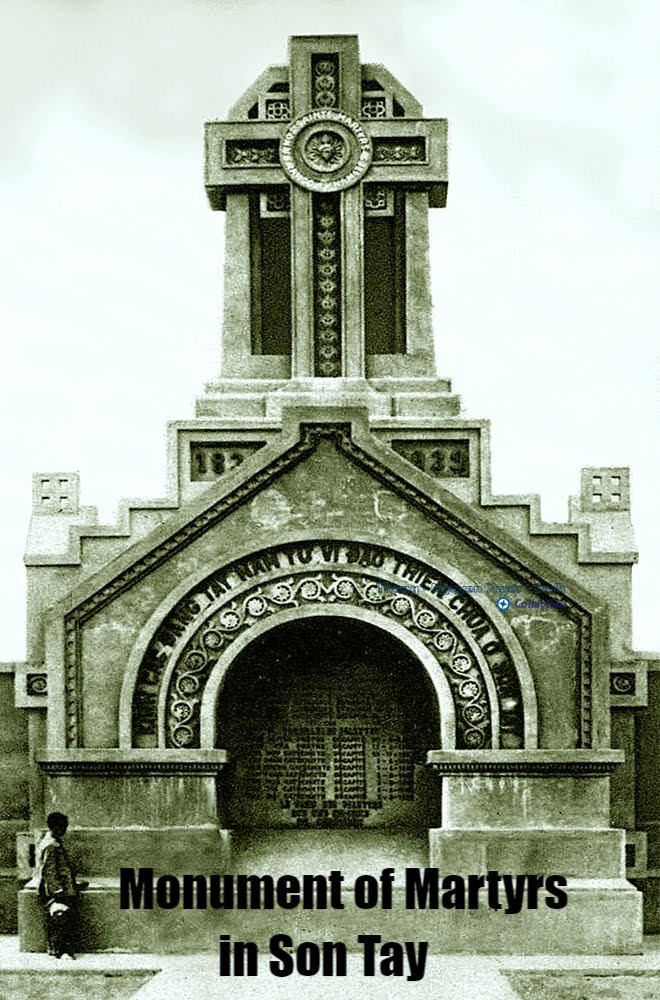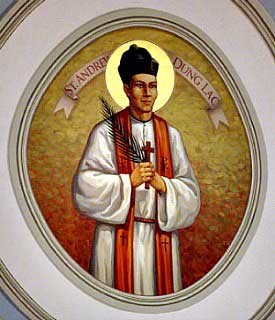Phu Cam Main Cathedral is situated at Phuoc Vinh Ward, Hue City. Characteristic: Phu Cam Cathedral was built in a modern architectural style, designed by the architect Ngo Viet Thu.
In early 1963, the construction of the cathedral was built. To 1965 only the Saint Palace was built and then to 1967, the cathedral was basically completed. Supporting pillars were concreted closely attached to the walls and gradually bended ahead. The three supporting pillars at each of four corners stretch out and create a fairly large space to embrace the whole of Saint Palace and Saint Altar.

The Saint Palace is a round shape with foot steps and on the top there is a smaller round shape with the altar made of marble bloc. Temporary house was closely built to the backstage of the cathedral fitted in the concave part behind and settle on a high platform in the center. In the two wings of the crucifix, there is the tomb of the former Archbishop Philipe Nguyen Kim Dien (1921-1988) in the left and in the opposite right – the altar for presenting the Saint.
The interior of the cathedral was built following classical tradition with Latin Holy Cross and two doors. There are two row of colour glass windows located in the upper interior of the cathedral and in the middle, there is a Holy Cross made of steel and concrete.
In front of the Phu Cam Main Cathedral there are two moulding statues: the right is the Saint Phero, the left is Saint Paulo and other missionaries of the Phu Cam diocese. The open-space of Phu Cam main cathedral looks like an opening-mouth-dragon and in general Phu Cam Cathedral with its top perpendicularly stretching to the sky is very purified and full of artistic and religious characters.
Hue is a center of spiritual affairs in Việt Nam, both Buddhist and Catholic. During the trying days of the early 1960s, President Ngô Ðinh Diệm of the old Republic of Việt Nam was haunted by the politically active Buddhists of Hue. One of the most captivating newspaper photographs ever taken was of Buddhist monk Thích Quảng Ðức, who lived in a pagoda in Huê, burning himself to death in Sài Gòn in 1963. One of Ðiem’s brothers was Ngô Đinh Thuc, who became the Catholic Archbishop of Huê in 1960 when the archdiocese was created. The seat of his archdiocese was Phủ Cam Cathedral.
The beginnings of Phủ Cam go back to 1680. By that time there were approximately 400 Vietnamese Catholics in Hue. Phêrô (Vietnamese for Peter) Lǎng built a small chapel in the An Cưu area of town. (Look on the lower right of the map of Huê – the link is on the left side of this page.) Soon thereafter, he built a small church at the present location at the base of a hill overlooking the An Cưu irrigation canal. (See bottom of map.) Today, the neighborhood surrounding the church is known as Phu Cam.
In 1902, the building was renovated and enlarged. The northern European architecture seemed a bit incongruous in Việt Nam. Sometimes in the early 1960s, President Diem and his brother the Archbishop had the building demolished to make way for the construction of a newer building.

The current building was designed by Ngô Việt Thu (1926-2000). Thu was a French-trained Vietnamese who designed other buildings in Hue, including the main classroom buildings at Đại Học Sư Phạm (teacher’s college) where we teach, the Đông Ba market, and the Cưu Thế Catholic church.) Construction on the new Phủ Cam began in 1965. The main building was finished enough to serve as a refuge for civilians trying to escape the heavy fighting that engulfed the city in February, 1968. However, the building was incomplete when Việt Nam was reunited in 1975. The two soaring steeples were finished one at a time, the last in 1999.
Today, Phủ Cam is a beautiful building, and it is the seat of the Diocese of Hue, one of twenty six in Việt Nam. It sits at the base of Ngư Bình, a large hill that forms the southern edge of the city. On the grounds are a small school for elementary-aged children, and the rectory for the priests. The bishop resides elsewhere.
Like cathedrals in northern Europe, it is classically shaped in the form of a cross, with the altar at the center. In the picture at the right, pretend you are standing in the main aisle near the first row of pews. A different perspective is at the left. Just imagine you took about twenty steps to your right and are looking over the lectern (the little stand where people read the Bible). The entire building is open and airy (perfect for tropical Việt Nam), with very a high vaulted roof. Large electric fans are mounted on the walls, and there are a number of portable fans near the altar to help cool off the clergy in their heavy robes. The one downside is the same problem I have with almost all Vietnamese buildings. It is “live”, meaning the building is all concrete and tile, with nothing to absorb sound waves. This results in a big echo. There are no tapestries, cushions on the seats, kneelers, or other bits of padding – not even carpet – to soften the reverberation.
From: http://www.huelocalguide.com/phu-cam-cathedral/history-of-phu-cam-cathdral/382.html
















